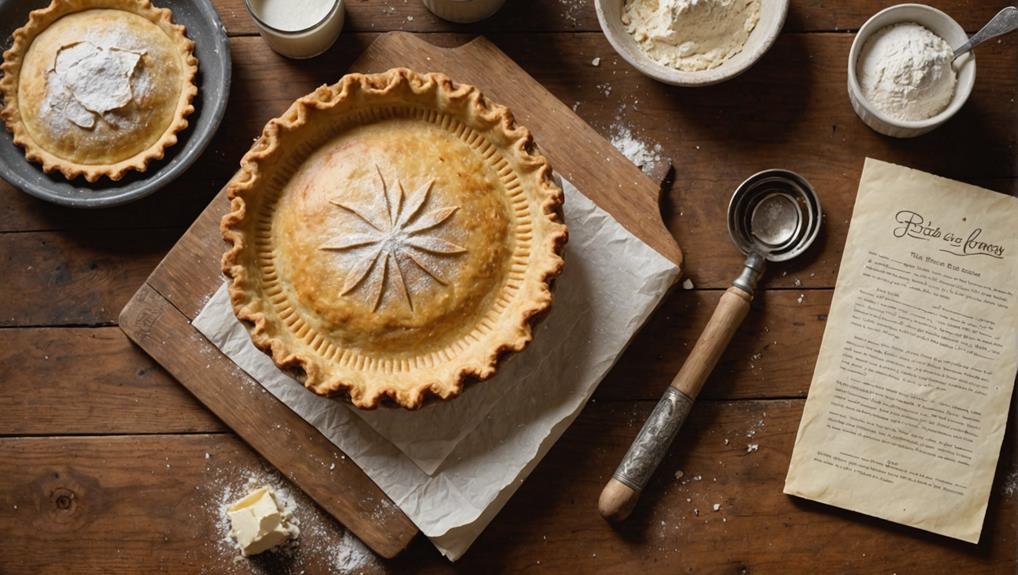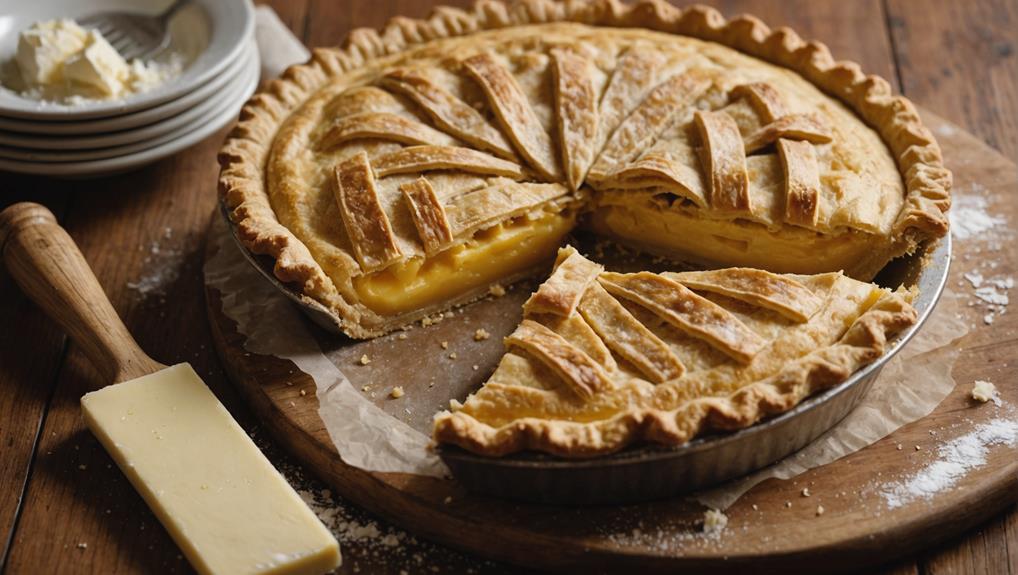To craft the perfect pie crust, start with high-quality, cold ingredients. Use all-purpose flour with 9-11% protein and incorporate ice-cold, cubed butter for flakiness. Chill your tools and ingredients before use, and don't overwork the dough. When rolling, aim for an even 1/8-inch thickness, rotating the dough frequently. For blind baking, use pie weights and dock the crust to prevent bubbling. Crimp the edges for a professional finish and always chill your formed crust before baking. These techniques, combined with patience and practice, will elevate your pie game. Master bakers know that the secrets to perfection lie in the details.
Selecting the Right Ingredients
When it comes to crafting the perfect pie crust, selecting the right ingredients can make or break your baking endeavor. Start with high-quality all-purpose flour, ensuring a protein content of 9-11% for proper gluten formation. This balance is crucial for achieving the ideal crust texture, providing structure without becoming tough.
For that coveted flaky texture, you'll want to use cold butter, cubed and kept chilled until ready to use. As it melts during baking, it creates steam pockets that contribute to the crust's delicate layers.
To further enhance your pie crust, consider incorporating vinegar or vodka into the dough. These secret ingredients help relax gluten, improving texture and preventing shrinkage.
Experiment with the fat ratio by combining butter with shortening or lard. While butter offers unparalleled flavor, shortening or lard can elevate flakiness to new heights.
For sweet pies, add a touch of powdered sugar to create a more delicate texture and balanced flavor. However, when crafting savory crusts, omit the sugar entirely.
Mastering the Chilling Process
With your ingredients carefully selected, it's time to focus on the chilling process—a key step in creating the perfect pie crust. To achieve that flaky crust you're aiming for, you'll need to master the art of temperature control.
Start by using ice-cold water when mixing your dough; this helps maintain the cold temperature crucial for optimal texture. Before incorporating them into the mix, refrigerate all fat components, such as butter or shortening. This prevents them from melting into the flour prematurely.
For innovative bakers seeking to elevate their technique, try chilling the flour itself. Pop it in the refrigerator for 5-10 minutes before use to further inhibit butter melting.
Once you've mixed your dough, it's essential to let it rest. Chilling dough for at least an hour allows the gluten to relax, resulting in a more tender and manageable crust.
Short on time? Wrap the dough in plastic and freeze it for about 30 minutes. This quick-chill method still provides the benefits of a relaxed gluten structure, ensuring you're on your way to crafting a perfect pie crust worthy of a master baker.
Rolling Techniques for Success

The rolling pin stands ready as you approach the next crucial step in pie crust perfection. Your mission: to achieve an even thickness of 1/8 inch across your pie dough, ensuring consistent baking and a flawless final product.
Begin by lightly flouring your work surface and rolling pin, striking a delicate balance to prevent sticking without compromising texture. As you roll, apply a gentle touch with even pressure, avoiding the temptation to overwork the dough.
Innovation comes in the form of technique: rotate your dough a quarter turn every few rolls, maintaining a circular shape and uniform thickness throughout. If you find your dough becoming warm and unruly, don't hesitate to chill it briefly. This pause allows you to regain control and handle the dough without tearing.
Remember, your rolling pin is a precision tool, not a weapon. Treat it with respect, and it'll reward you with a perfectly rolled crust.
The Art of Blind Baking
Now that you've mastered rolling techniques, it's time to tackle blind baking – a key step in creating pies with wet fillings. This innovative process prevents sogginess by partially cooking your crust before adding the filling.
To blind bake, line your crust with parchment paper and fill it with pie weights or dried beans. These weights maintain the crust's shape during baking.
Set your oven to 375°F (190°C) and bake for 12-15 minutes, until the edges turn golden brown. After removing the weights and parchment, bake for an additional 5-10 minutes to ensure the bottom is fully cooked. This extra step prevents moisture from seeping into your crust.
Don't forget to dock your crust before baking! Use a fork to create small holes, allowing steam to escape and ensuring even cooking. This technique prevents bubbling and helps achieve that perfect, flaky texture.
Creating Flaky, Fluted Perfection

For flaky, fluted perfection, start with ice-cold ingredients. Your butter and ice water will be the key players in maintaining the dough's temperature, crucial for achieving that coveted flaky texture.
As you incorporate the butter into the flour, aim for a mixture resembling coarse crumbs, ensuring visible butter chunks remain. This technique is essential for optimal flakiness.
When you're ready to roll the dough, aim for a uniform thickness of about 1/8 inch. Rotate frequently to maintain a circular shape and prevent sticking.
Here's where the artistry comes in: crimp the edges for a decorative finish that also seals the crust, preventing filling leaks during baking.
One of the most crucial crust tips and tricks is to chill the formed crust in the refrigerator for at least 20 minutes before baking. This step allows the gluten to relax, ensuring a tender and flaky result.
Frequently Asked Questions
What Is the Secret to Making Good Pie Crust?
You'll master pie crusts by using cold butter, the right flour types, and proper rolling techniques. Chill your dough, perfect ingredient ratios, and experiment with flavor variations. Don't forget pie weights for blind baking and nailing the ideal crust thickness.
What Is the Most Important Rule in Making a Pie Crust?
You'll find the golden rule of pie crusts is keeping everything cold, especially the butter. This chilly approach, combined with precise flour types, salt ratios, and mixing techniques, ensures a flaky texture that'll revolutionize your baking game.
What Are the 5 Tips for Pie Perfection?
For pie perfection, you'll want to: keep butter cold for flaky texture, master your rolling technique, chill dough between steps, nail ingredient ratios, and perfect your mixing method. Don't forget blind baking, crust color, filling interaction, and edge decoration.
What Does Adding Vinegar to Pie Crust Do?
Unlock the alchemy of pie perfection! Adding vinegar to your crust is a game-changer. You'll enhance flavor, improve texture, and master moisture balance. Its acidity tames gluten, boosting elasticity and flakiness. Embrace this pastry science for innovative baking chemistry.
Final Thoughts
You've now unlocked the secrets to crafting pie crusts like a master baker. With the right ingredients, chilling techniques, and rolling methods in your arsenal, you're ready to create flaky, golden perfection. Remember, practice makes perfect, and each pie you bake will be better than the last. As you work the dough, imagine it's like sculpting fine marble, revealing the masterpiece within. Your homemade pies will soon rival those of seasoned professionals, delighting friends and family with every buttery, crisp bite.















